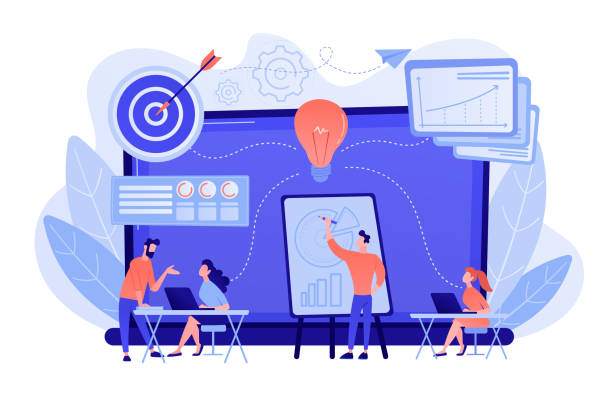Why is Multilingual Website Design a Necessity? Understanding Global Needs

In today’s world where geographical borders are rapidly blurring, an online presence in only the mother tongue is not enough.
#Multilingual_Website_Design is no longer a competitive advantage, but a strategic necessity for any business looking to expand its markets and reach international audiences.
When a website is available in multiple languages, it not only allows communication with potential customers from all over the world, but also significantly increases brand credibility and trust.
Imagine a user from another country visiting your website and being able to read your content in their native language; this positive user experience greatly increases their likelihood of converting into a customer.
Ignoring this issue can mean losing a large share of the global market.
The goal of multilingual website design is not just a mere translation of text, but also includes localization of content, culture, currency, and even the display of dates and times.
This comprehensive approach provides a more integrated and convenient user experience for visitors.
From a digital marketing perspective, a multilingual website helps improve search engine rankings for various keywords in different languages, which in turn leads to increased organic traffic and business growth.
This is a smart decision for any company seeking sustainable growth and development on an international scale, and is in a way an explanatory approach to demonstrating the importance of this field.
Are you frustrated with the low conversion rate of your online store?
RasaWeb is your definitive solution with professional e-commerce website design!
✅ Increase your sales and revenue
✅ Unparalleled user experience for your customers
⚡ Get a free consultation now!
Technical and SEO Considerations in Multilingual Website Development

When it comes to multilingual site design, technical and SEO aspects are of paramount importance.
One of the first decisions is choosing the appropriate URL structure: subdomains, subdirectories, or country-code top-level domains (ccTLDs).
Each of these options has its own advantages and disadvantages from an SEO perspective.
For example, subdirectories (like example.com/fr) are often preferred for SEO because they inherit the main domain’s authority, while ccTLDs (like example.fr) convey a stronger sense of locality to users but require separate SEO management for each domain.
Correct use of the hreflang tag is also crucial.
This tag helps search engines display the correct language version of your website to users based on their geographical location and browser language settings.
Without this tag, search engines might perceive translated content as duplicate content, which can harm your SEO ranking.
This section specifically addresses technical aspects.
Furthermore, page loading speed, Responsive Design, and image optimization are equally important for multilingual websites.
Choosing suitable hosting that can serve visitors from different parts of the world can impact loading speed and user experience.
Also, for multilingual SEO, special attention must be paid to keywords specific to each language and culture.
Direct translation of keywords may not be optimal and may not attract the target audience effectively.
Keyword research should be conducted separately for each language to ensure that the content matches the phrases real users search for in that language.
This approach guides how a multilingual website can be technically and SEO-optimized.
Implementation Strategies for Multilingual Website Design

Choosing the right strategy for implementing multilingual site design is a crucial step that directly impacts your site’s efficiency, maintainability, and SEO.
There are three main methods for this: using independent domains (ccTLDs), subdomains, and subdirectories.
Each of these has its own advantages and disadvantages, and the final choice should be based on your business objectives, available resources, and desired structure.
For example, independent domains like .fr for France or .de for Germany give users a very strong sense of locality, and search engines recognize them as completely separate websites specifically for that region.
However, managing these domains, including separate SEO for each, can be complex and costly.
This section is somewhat educational.
Subdomains (e.g., fr.example.com) are another option that are technically simpler than independent domains, and search engines treat them as distinct entities from the main domain, though they usually benefit slightly from the main domain’s authority.
In contrast, subdirectories (e.g., example.com/fr) are highly popular because they perform very strongly in terms of SEO (due to inheriting all of the main domain’s authority) and are easier to manage.
For building a multilingual website, platform selection is also very important.
Content Management Systems (CMS) like WordPress with plugins such as WPML or Polylang, Joomla, Drupal, or custom-built systems, each offer different capabilities for managing multilingual content.
The table below compares these methods:
| Method | Advantages | Disadvantages | SEO Note |
|---|---|---|---|
| Independent Domains (ccTLDs) | Strong local feel, best for local SEO | High cost, separate management for each domain, requires independent SEO | Independent authority for each country |
| Subdomains | Easy setup, content separation, relatively independent of main domain | Less local perception than ccTLDs, requires almost independent SEO | Search engines may view it as a separate site |
| Subdirectories | Best for SEO (inheriting main domain authority), easy management | May have less local feel than ccTLDs | Maximizes main domain authority utilization |
Correctly choosing these strategies lays the foundation for successful multilingual website development.
Challenges of Content Translation and Localization; Beyond Words

Content translation and localization in the multilingual site design process goes far beyond simply replacing words from one language to another.
This stage can be highly questionable and brings with it many cultural, linguistic, and even technical challenges.
Merely using machine translation tools, while useful for general understanding, cannot accurately convey cultural nuances, local idioms, appropriate tone, and indigenous keywords.
A poor translation not only damages your credibility but can also lead to misunderstanding or even offense to local audiences. To illustrate, a marketing campaign successful in one country might fail in another due to cultural differences, even if the text has been correctly translated.
Localization involves adapting content to the specific characteristics of the target market; including currency, date and time format, phone numbers, addresses, and even colors and images.
Colors have different meanings in different cultures, and an image attractive in one culture might be considered inappropriate in another.
Therefore, collaboration with native translators and marketing professionals who have a thorough understanding of the target culture and language is essential.
These individuals can ensure that your content is not only linguistically correct but also culturally appropriate and engaging.
Furthermore, optimizing content for Local SEO should also be considered.
This includes using local keywords, specific city names, and phrases that people in that region search for.
This analytical approach helps us understand the depth of localization challenges and properly plan for creating a multilingual portal.
Are you concerned about your e-commerce site’s low conversion rate and not achieving your desired sales?
RasaWeb is your specialized solution for a successful e-commerce website!
✅ Significant increase in conversion rate and sales
✅ Professional and user-friendly design to satisfy customers
⚡ Ready for a transformation in online sales? Get a free consultation!
Excellent User Experience in Multilingual Websites

Designing an excellent User Experience (UX) in multilingual site design is far more complex than designing for a single language.
The goal is for the user, regardless of their native language, to easily navigate the site and find the information they need.
One of the most important aspects is placing a Language Switcher in an accessible and clear location. This switcher should be easily recognizable, and users should be able to select their desired language with one click.
Using country flags for language selection can sometimes be misleading, as one language might be spoken in multiple countries (like Spanish in Spain and Latin America) or a country might have multiple official languages (like Canada).
Therefore, it is better to use the full language name (e.g., “فارسی”, “English”) or language code (fa, en).
Furthermore, the site layout must be flexible for different languages.
Some languages are written Right-to-Left (RTL) (such as Persian and Arabic), while most other languages are Left-to-Right (LTR).
This difference can affect text alignment, navigation direction, menu placement, and images.
Ensuring that all UI/UX elements are displayed correctly in every language is crucial.
Fonts must also be compatible with different languages and render correctly.
Page loading speed must be optimized in all languages, as loading delays can harm the user experience.
This approach provides a comprehensive guide to ensure that multilingual website development is carried out in the best possible way, and international users also enjoy visiting your site.
Common Mistakes in Multilingual Site Design and Solutions to Avoid Them

In the process of multilingual site design, there are common mistakes that can render your efforts futile and even harm your brand.
One of the biggest mistakes is ignoring the need for complete content translation and localization. Some assume that machine translation or incomplete translation is sufficient, while this can lead to misunderstandings, inappropriate tone, and even loss of customers.
The solution is to always use professional native translators who are proficient not only in the language but also in the culture of the target region.
Another mistake is not optimizing SEO for each language.
Many only focus on the SEO of the main language and forget that keywords, meta tags, and descriptions in each language must be optimized separately, considering how searches are performed in that language.
Incorrect use of hreflang tags can also harm SEO and cause search engines to perceive translated content as duplicate content.
This section is educational for avoiding these problems.
Ignoring user experience (UX) is also a major mistake.
A multilingual site must have a seamless and easy-to-use interface, regardless of which language the user is using.
This includes placing the language switcher in an accessible location, supporting RTL direction for specific languages (like Persian and Arabic), and ensuring correct font display.
Furthermore, forgetting testing and quality assurance (QA) after implementation can lead to linguistic bugs, display issues, and broken links.
The site must be regularly tested in all languages and on different devices. This explanatory approach helps us avoid falling into these mistakes and achieve an efficient and successful multilingual site design.
Paying attention to these key points ensures success in global markets and guarantees a successful multilingual portal creation.
Key Tools and Platforms for Multilingual Website Design

Choosing the right tools and platforms for multilingual site design can make a significant difference in the ease of development, maintenance, and scalability of your website.
Today, there are numerous Content Management Systems (CMS) that support multilingual capabilities or offer plugins for this purpose.
WordPress, as the most popular CMS in the world, with plugins like WPML and Polylang, easily enables multilingual website creation.
WPML is a powerful plugin with comprehensive content translation capabilities, including posts, pages, categories, and even theme strings.
Polylang is also a lighter and free option that allows you to easily manage multilingual content.
This section is somewhat informative and specialized.
For larger and more complex projects, CMSs like Drupal and Joomla also have strong, built-in multilingual capabilities that require fewer plugins and are more suitable for enterprise websites and large-scale projects.
Drupal in particular is known for managing complex content and multilingual data structures.
In addition to CMSs, Translation Management Systems (TMS) also exist that simplify and make the translation process more efficient.
These tools enable collaboration between translators, editors, and project managers and can be integrated with your CMS.
Platforms like Transifex, PhraseApp, and Lokalise are examples of TMS that help you keep the localization process organized and centralized.
A comparative table of some tools is provided below:
| Tool/Platform | Type | Key Advantages | Use Case |
|---|---|---|---|
| WPML | WordPress Plugin | Comprehensive, strong support, compatible with themes and plugins | WordPress websites needing high control over translation |
| Polylang | WordPress Plugin | Free, lightweight, simple user interface | WordPress websites with limited budget or simpler needs |
| Drupal | Content Management System | Strong built-in multilingual capabilities, high scalability | Large and complex enterprise projects |
| Transifex | Translation Management Tool (TMS) | Team collaboration, integration with Git and CMSs | Projects requiring extensive collaboration in the translation process |
Correctly choosing these tools will lead to the optimization of the multilingual portal creation process.
Maintenance and Updates of a Multilingual Website

After completing multilingual site design and launching it, the work does not end.
Regular maintenance and updates of a multilingual website are crucial to ensure proper functioning and provide a seamless experience to users.
One of the most important aspects is maintaining the quality of translations and localizations. With content updates, adding new products or services, or changes in marketing messages, it must be ensured that all language versions are also updated and match the original content.
This process should be continuous and in collaboration with the translation team.
Using Translation Memory and Terminology can help maintain consistency and quality of translations over time.
In addition to content, the technical aspects of the website also require regular maintenance.
This includes checking for broken links in all languages, ensuring the language switcher functions correctly, testing compatibility with various browsers and mobile devices in each language, and checking page loading speed.
Updating plugins and themes in the CMS also needs to be done carefully to ensure no interference with multilingual capabilities.
Furthermore, monitoring multilingual SEO performance through tools like Google Search Console for each language is very important.
This helps you identify and resolve potential issues in content indexing and ranking.
Regular and meticulous maintenance ensures the long-term stability and success of your multilingual website in the global market. This section is a practical guide for efficient management of a multilingual website.
Is your current e-commerce website design not generating the sales you expect?
RasaWeb specializes in professional e-commerce website design!
✅ An attractive and user-friendly site aimed at increasing sales
✅ High speed and security for an ideal shopping experience⚡ Get a free online store design consultation with RasaWeb!
Successful Case Studies; Learning from the Best

Reviewing successful case studies in multilingual site design can be inspiring and entertaining, providing valuable lessons.
Many global brands have achieved significant success using smart multilingual strategies.
For example, Airbnb, a global accommodation booking platform, utilizes a fully localized website in dozens of languages.
They not only translate textual content but also adapt the user experience based on the culture of each region; from displaying local currency units to providing customer support in various languages.
This comprehensive approach has helped Airbnb grow rapidly in international markets and become a leader in the travel industry.
This is an excellent example of a successful multilingual site design that has gone beyond simple translation.
Another example is the IKEA website.
This global furniture brand, despite its product designs being the same worldwide, localizes its website.
This localization includes language, currency, specific regional product inventory, and even marketing communications.
They use ccTLDs (country-code top-level domains) to reinforce the sense of local presence in each market.
This strategy has helped IKEA, despite being global, be recognized as a local and accessible brand in each geographical region.
These case studies show that investing in complete localization and paying attention to cultural details is not merely an expense, but a smart investment for global growth and success. This analysis of successes provides new perspectives on creating a multilingual portal and proves that with the right approach, ambitious goals can be achieved.
Multilingual Content Management; Advanced Solutions

Managing multilingual content in the multilingual site design process requires advanced solutions to ensure that content is always up-to-date, accurate, and of high quality in all languages.
One effective approach is to use Content Management Systems (CMS) with built-in multilingual capabilities or specialized plugins that provide integrated content management.
These systems should be capable of creating and editing content in all languages from a single panel and simplifying the translation process.
Additionally, managing images and media for different languages is of great importance. For example, an image might require different captions or even changes for cultural compatibility.
This section is somewhat specialized.
Another solution is to implement an efficient translation workflow that includes content creation, submission for translation, review, and publication.
This workflow can include the use of Translation Memory (TM) which helps store previous translations and prevents re-translating repetitive phrases, saving both time and helping maintain consistency in terminology and tone.
Also, Terminology Management, by creating a shared glossary for all translators, ensures that key industry-specific terms are translated consistently across all languages.
These approaches help you reduce the complexities of multilingual content management and increase the efficiency of the multilingual website development process. This ensures that the quality and accuracy of content are maintained in all languages and your international user experience is the best possible.
Frequently Asked Questions
| Question | Answer |
|---|---|
| What is a multilingual website? | A website whose content is available to users in more than one language. |
| Why should I make my site multilingual? | To reach more audiences in global markets, improve user experience, and enhance international SEO. |
| What are the technical approaches to building a multilingual site? | Using subdirectories, subdomains, or URL parameters to differentiate languages. |
| How does multilingual design affect SEO? | By targeting local keywords and providing content in users’ native language, the site’s ranking in search engines for those regions improves. |
| What are the challenges of multilingual site design? | Managing content translation, supporting Right-to-Left (RTL) direction, technical issues related to language addressing, and maintaining design consistency. |
| How do we choose the languages for a multilingual site? | Based on target audience analysis, target markets, and current site traffic data (if available). |
| What is RTL support and why is it important for some languages? | Right-to-Left, the direction of text and page elements display from right to left, which is essential for languages like Persian, Arabic, and Hebrew. |
| How do we manage multilingual site content? | Using Content Management Systems (CMS) with multilingual capabilities, translation plugins, or professional translation services. |
| How is the user experience (UX) in a multilingual site? | The ability to easily change languages should be provided, and translated content should be of high quality so that users feel comfortable. |
| What are the common CMS platforms for multilingual sites? | WordPress (with plugins like WPML), Joomla, Drupal, and Shopify (with relevant settings or plugins). |
And other services of RasaWeb advertising agency in the field of advertising
Smart Website Development: A creative platform for improving sales with intelligent data analysis.
Intelligent Data Analysis: A professional solution for digital branding focusing on intelligent data analysis.
Intelligent Link Building: Revolutionize SEO ranking by using real data.
Intelligent Marketplace: An effective tool for analyzing customer behavior with attractive UI design.
Intelligent Link Building: A creative platform for improving customer acquisition by optimizing key pages.
And over a hundred other services in the field of internet advertising, advertising consulting, and organizational solutions
Internet Advertising | Advertising Strategy | Advertorial
Sources
Comprehensive Guide to Building a Multilingual Website
Key Tips for Website Localization
Multilingual SEO Strategy for Global Success
Expanding Business to Global Markets
? Are you ready to advance your business in the digital world? RasaWeb Afarin’s expert team, by providing comprehensive digital marketing services, including SEO optimized website design, helps you achieve your big goals and have a powerful online presence. For consultation and to start your business’s digital transformation, contact us today.
📍 Tehran, Mirdamad Street, next to Bank Markazi, Southern Kazeroon Alley, Ramin Alley, No. 6




